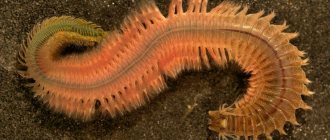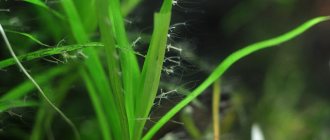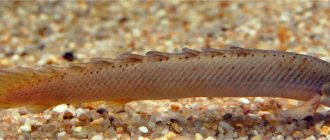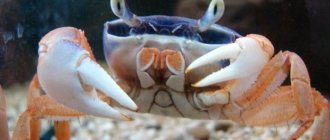The fan worm is a beautiful and interesting inhabitant of aquariums. The best keeping option is a mature aquarium with rich microfauna and live rock. It is worth noting that the worm tubes are placed in holes specially made in stones or between stones. A constant change of food-bearing water around the corolla should be ensured by moderate circulation. Lighting is not very important for keeping fan worms. Given a sufficient amount of food and suitable conditions, the aquarium inhabitants in question are capable of living in captivity for a long time.
For the fanworm, brittle stars and starfish can pose a threat. It is recommended to keep these inhabitants separately. Animal-derived planktonic foods, phytoplankton and proprietary coral foods can be added as additional nutrition.
CLASS: POLYCHAETA. FAMILY: SABELLIDAE AND SERPULIDAE.
BISPIRA, Yellow Feather duster
Most worms known to saltwater aquarium hobbyists are attached and belong to two families: Sabellidae, commonly called sabellidae, and Serpulidae. living in limestone tubes. All these species live permanently in tubes and usually produce one or more feather-like tentacles, with which they feed and breathe. Typically, these tentacle feathers look very beautiful and come in bright colors - blue, red, yellow, white, orange, green, lilac, violet, beige and brown.
These worms capture tiny particles of food into their feather crown. From there it enters, and then with a stream of mucus into the central mouth. This feather crown is very sensitive to the slightest movements nearby and instantly retracts. This reaction is controlled by giant nerve fibers that run along the entire body of the worm inside the main nerve trunk.
These worms are usually found in the sand or mud of shallow tidal areas. They mix pieces of dirt with mucus and thus build parchment-like tubes in which they live. The length of the tubes varies - from 2.5 cm to 10 cm, depending on the type. Sabellids are social creatures and live in large colonies, especially in areas where food is abundant. Usually their coloring is muted and limited to beige, brown, black, dark red, purple and white. The most commonly found species on sale are Sabellastarte magnified and S. sanctijosephi.
SABELLASTARTE, Big Brown Feather duster
Sabellids can be placed in sand or on rocks - they adapt equally well in both places.
Jellyfish
Air creatures can be incredibly dangerous. Their stinging cells contain poison. The most dangerous jellyfish you can encounter on the beach are the yellow round box jellyfish and the “Portuguese man-of-war”, a beautiful blue-violet color.
Jellyfish "Portuguese Man of War"
Box jellyfish (sea wasp)
Where do they meet?
: beaches of Southeast Asia, Mediterranean Sea, Indian and Pacific Oceans.
Security measures
: try not to go to the beach after a storm - jellyfish wash up on the shore and the chance of meeting them is very high.
If you are stung by a jellyfish, call a doctor. After a bite, do not rub the wound or pull out the sting. While you wait for help, you can apply a dry compress and rinse the area with sea water. And forget the tales of miracle cures of urine, vinegar and alcohol!
Sea fleas
Let's say right away that sea fleas bite very rarely, but the consequences of the bites appear immediately. Miniature insects can cause unpleasant rashes and irritations. All fleas bite - both females and males. But the bites of males will only leave irritation and itching, and the consequences of bites of females are more serious. These fleas stick to a person and drink blood, so the bite can become inflamed and fester if the body of the insect remains in it.
You can encounter sea fleas along the surf line, in storm-tossed algae. Also, a large colony can make quiet sounds. Do you hear a barely noticeable howl on a wild beach? Then it's better not to walk barefoot on the sand!
Where do they meet?
: on sandy beaches. In Southeast Asia (Thailand, Vietnam), India, South America, Africa, even on the Black Sea coast in Russia.
Security measures
: do not swim at dawn and sunset, do not walk barefoot on a wild beach, wash your feet after walking on the sand. If a flea has bitten you and nothing but itching bothers you, take an antihistamine and anoint the wound with a soothing cream. If the insect's head is visible in the wound and there is pus, then you need to go to the hospital. Trying to get a flea on your own using oil, like a tick, will not work.
Causes of nematodes
Nematodes occur both in an old tank that has been in use for a long time, and in a new, clean aquarium, even if the tank has been disinfected before use. White worms are guaranteed to appear in a pond if:
- There are food residues in the tank. When fish are overfed, excess food sinks to the bottom, where it rots and becomes a breeding ground for the development of nematodes.
- New decorative objects – carriers of larvae – are placed in the reservoir.
Fire worms
Despite the creepy name, they look quite cute: a bright orange caterpillar with fluffy white bristles. The size can reach 40 cm, but usually it is about 10 cm. Some wildlife lovers find it difficult to restrain themselves from grabbing the handsome man in their hands. This should not be done under any circumstances: the worm instantly parts with its bristles, they scatter in the water and stick straight into your hands. The spines contain capsules containing poison containing a neurotoxin. The skin turns red, swells, dizziness and nausea begin.
Where do they meet?
: Mediterranean Sea, Adriatic coast.
Security measures
: Do not swim on wild beaches - fireworms accumulate right in the shallow water between the rocks. They themselves are timid and non-aggressive; they will not attack unless disturbed. If you are diving on an unequipped beach, wear rubber slippers - they will protect your feet.
If you are injured by a fireworm, you need to remove the poison capsules. Use tweezers if you see spines, or regular tape if the bristles are not visually visible. After this, the wound should be wiped with alcohol. And don’t forget to see a doctor - if the affected area is large, you will be prescribed antibiotics.
Nutrition
The sea fireworm is a voracious predator. Its diet consists of hard corals, anemones and small crustaceans, occasionally including plants. If possible, it also attacks larger underwater inhabitants: wounded starfish, rock urchins. And although the worms do not have any claws or powerful jaws, the hunt for them always ends successfully, especially in a situation where these creatures attack in a group of several individuals. As the experiments of biologists who put hedgehogs and worms in the same aquarium show, the latter are able to gnaw the victim from the inside, crawling into its mouth.
When feeding in reefs, they eat corals, their upper parts and branches. In doing so, they remove the coral layer directly from the skeleton, leaving behind white tips. This is a characteristic sign of their presence in a given place. The process of gnawing each coral branch takes 5-10 minutes. Therefore, in one day they cause quite significant damage to all the corals around.
Sea urchins
Walking along the water's edge, you can easily step on a sea urchin hiding in the rocks. The main danger is sharp needles up to 30 centimeters long. If one of them digs into your leg, it could ruin your vacation. The foot swells, the temperature rises, and the wound festers.
Where do they meet?
: coast of North and South America, New Zealand, Red and Mediterranean Seas. They live in rocks and are rarely found on sandy beaches. Often seen on wild beaches.
Security measures
: Rubber swimming slippers can save you. When you enter the water, carefully inspect the bottom and be vigilant while diving. If a hedgehog thorn does attack you, do not try to remove it yourself: it is very fragile and will break easily. It is better to go to the hospital immediately.
If it is not possible to go to the hospital, you can first hold the leg with the thorn in hot water and then carefully pull it out. Treat the wound with an antiseptic.
Study of unusual glow
At this point, biologists were able to capture bristly fireworms for research in the laboratory. They showed that the glow can be observed under certain conditions: up to a temperature of -20 ° C, but gradually fades away as it decreases. Reducing the oxygen level has no effect on the glow.
Analyzing the data obtained, biologists made conclusions about the presence of photoprotein in the secretion of such marine worms. For the discovery of this substance in 2008, Japanese biologist O. Shimomura received the Nobel Prize in Chemistry.
Lionfish (zebra fish, lion fish)
The lion fish, zebra fish or lionfish is a beautiful striped creature with large fins, inside of which a dangerous poison is hidden. You can meet the fish while diving. She lives near coral reefs, in shallow waters. It is quite possible to observe her from afar - she does not attack herself. But if you disturb a zebra fish, it will release its fin-spines with poison. It will be painful, possible fainting and even muscle paralysis.
Where do they live?
: Red Sea, Indian Ocean
Security measures
: Try not to disturb lionfish while diving. If you run into a dangerous thorn, wash the wound with hydrogen peroxide and, if you find it, treat it with Epsom salts (magnesium sulfate) - this will help neutralize the poison. Then lower it into hot water up to 45 degrees so that it doesn’t burn. It will feel better in 10-15 minutes. After this, disinfect the wound again and take an antihistamine.
Watch the video on how to save yourself from a fish bite
Sea snakes
It's serious
: Snakes living in water produce more toxic venom than their terrestrial counterparts.
The good news is that when bitten, very little venom is released to seriously harm a person. Only 2 species of sea snakes are deadly. But a meeting with the safest of them cannot be called pleasant - the bite will hurt, tumors, swelling, allergies, and weakness are possible. In water, animals do not attack and try to hide as quickly as possible. But if a snake has washed up on land, you definitely shouldn’t touch it.
Where do they meet?
: warm seas of the Pacific and Indian oceans, most of all in the South China Sea.
Security measures
: Do not touch sea snakes. They are shy and will not attack themselves. If you manage to get a snake bite, there is no need to wipe it with vinegar. And don’t even think about “treating yourself” with alcohol - it promotes vasodilation and rapid absorption of poison. You can try to suck out the poison with a blood-sucking jar, syringe or mouth (but only if there are no wounds in the mouth).
Micro sea, beginning
About a year ago. In one of the companies I saw a neglected marine aquarium... Everything... as they say, was completely covered! There are plans for a large, well at least for me large, marine system for 450-500 liters. A marine aquarium requires a lot of time and financial investment, and I really want a piece of the sea right now. What to do? Organize your micro sea correctly! In general, I decided to start a small aquarium for now. I finally decided to start a marine aquarium. Let it be small for now. After the master class “The Sea with your own hands” that took place in “Living Water”, anyone interested can read it.
I decided to call the article a micro sea for two reasons: firstly, there is an aquarium of not quite standard sizes: width 36.5 cm, depth 26 cm, height only 15.5 cm, as they are also called “trough aquarium” . And secondly, I somehow don’t really like the name “nano”. In general, there will be a micro sea with a micro reef! In the process of setting up a micro sea, I will try to describe in detail all the stages, as well as indicate the finances spent on setting up this aquarium.
So, the aquarium turns out to be a “dirty” volume of 14.7 liters, minus the soil (2 kg is planned), minus another 2-2.5 kg of live stones, and also underfilling, it turns out to be about 9 liters. Naturally, I do not plan to keep inhabitants in this aquarium that are not intended for such small volumes. But nevertheless, I am confident that I will be able to select a sufficient number of interesting residents for the micro sea.
Stingrays
The animals spend most of their time motionless, so they may not be noticed in the sand. But if you disturb the stingray, it will be forced to sting. You will feel pain, dizziness, weakness. You should be concerned if the stingray wounded you in the chest or stomach. If the stingray stings the leg or arm, then there is no danger to life. The main thing is to properly treat the wound.
Where do they meet?
: Red Sea, Mediterranean Sea, Indian Ocean, Atlantic Ocean.
Precautionary measures
: do not walk on wild beaches barefoot, wear rubber slippers. If you are stung by a stingray, first wash the wound with sea water. Treat with hydrogen peroxide, place the limb in warm water and keep for at least 30 minutes. Take an antihistamine. After this, the pain should subside. Over the next few days, clean the wound with soap and water. If signs of suppuration appear, consult a doctor.
First aid
The very first step should be to remove the visible bristles using tweezers. Those that are almost invisible or transparent can be removed using tape or any adhesive tape. Then treat the affected area with a disinfectant or vinegar solution or ethyl alcohol. If pain and irritation do not go away for a long time, it is better to consult a specialist and be treated with antibiotic ointment. Hydrocortisone cream helps a lot. To relieve pain, painkillers are recommended: Ibuprofen, Nurofen, etc.
When inflammation or infection of the wound begins, it is better to use external antibiotics.
Anemones (anemones)
Do you think these are beautiful flowers underwater? No, these are living creatures - sea anemones from the order of sea cnidarians. Outwardly, they look like ordinary grass, only the colors are brighter and the leaves are fleshier. They grow in colonies near the shore, in rocks. Most sea anemones are safe; poisonous ones become active by September. If you touch some poisonous sea anemones, part of the tentacle breaks off and remains on the skin. The contact area hurts, like a burn.
Where do they meet?
: Mediterranean Sea, Adriatic
Precautionary measures
: Do not touch bright flower-like sea anemones. If you get a burn, rinse the wound with sea water and apply a hot compress. Then take an antihistamine.
With this article we in no way want to dissuade you from traveling and swimming in the sea! Sunbathing on equipped beaches, most tourists never encounter dangerous marine life. But forewarned means forearmed. Be a smart tourist and don't panic over the little things. And just in case, remember the safety rules at sea.
Video of an illegal crab in a new aquarium
Illegal crab
I bought a lamp for my micro sea. Wave Point LED lamp 16 W. white and blue diodes. Size 30 cm. Cost 3350 rub.
LED Marine Light
The filter had to be moved to the side wall because due to the lamp there was no other way to install it.
LED Marine Light
Several photographs of the micro sea.
Micro sea general view
Micro sea close up
Living stones
A week later, the first residents began to move in, and a colony of disc anemones was purchased.
Discoactinia in the micro sea
General form
I will describe the further development of the micro sea as the aquarium matures.











